tow CADILLAC ESCALADE EXT 2006 2.G Owners Manual
[x] Cancel search | Manufacturer: CADILLAC, Model Year: 2006, Model line: ESCALADE EXT, Model: CADILLAC ESCALADE EXT 2006 2.GPages: 484, PDF Size: 2.98 MB
Page 1 of 484
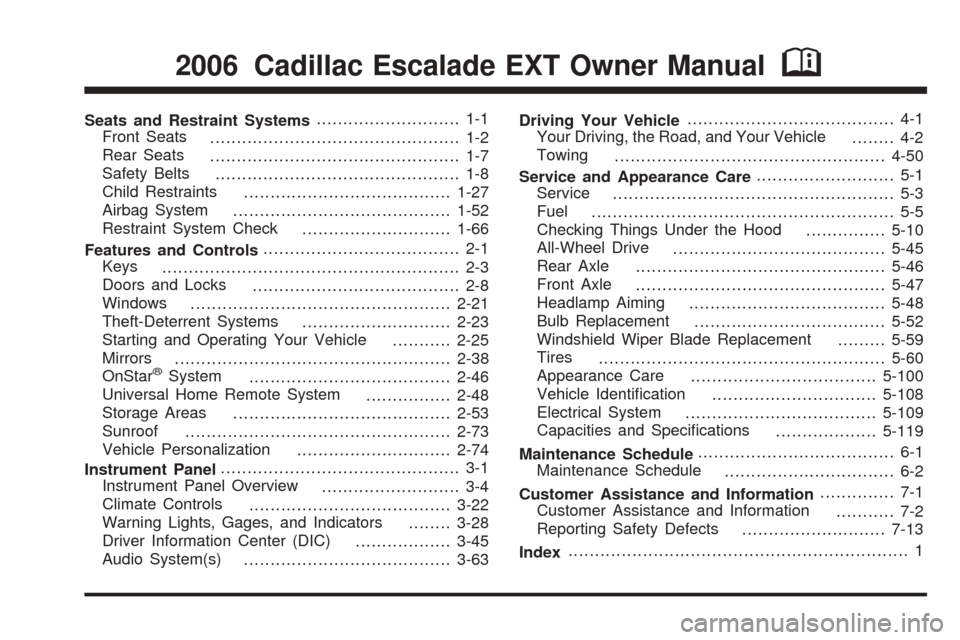
Seats and Restraint Systems........................... 1-1
Front Seats
............................................... 1-2
Rear Seats
............................................... 1-7
Safety Belts
.............................................. 1-8
Child Restraints
.......................................1-27
Airbag System
.........................................1-52
Restraint System Check
............................1-66
Features and Controls..................................... 2-1
Keys
........................................................ 2-3
Doors and Locks
....................................... 2-8
Windows
.................................................2-21
Theft-Deterrent Systems
............................2-23
Starting and Operating Your Vehicle
...........2-25
Mirrors
....................................................2-38
OnStar
®System
......................................2-46
Universal Home Remote System
................2-48
Storage Areas
.........................................2-53
Sunroof
..................................................2-73
Vehicle Personalization
.............................2-74
Instrument Panel............................................. 3-1
Instrument Panel Overview
.......................... 3-4
Climate Controls
......................................3-22
Warning Lights, Gages, and Indicators
........3-28
Driver Information Center (DIC)
..................3-45
Audio System(s)
.......................................3-63Driving Your Vehicle....................................... 4-1
Your Driving, the Road, and Your Vehicle
........ 4-2
Towing
...................................................4-50
Service and Appearance Care.......................... 5-1
Service
..................................................... 5-3
Fuel
......................................................... 5-5
Checking Things Under the Hood
...............5-10
All-Wheel Drive
........................................5-45
Rear Axle
...............................................5-46
Front Axle
...............................................5-47
Headlamp Aiming
.....................................5-48
Bulb Replacement
....................................5-52
Windshield Wiper Blade Replacement
.........5-59
Tires
......................................................5-60
Appearance Care
...................................5-100
Vehicle Identi�cation
...............................5-108
Electrical System
....................................5-109
Capacities and Speci�cations
...................5-119
Maintenance Schedule..................................... 6-1
Maintenance Schedule
................................ 6-2
Customer Assistance and Information.............. 7-1
Customer Assistance and Information
........... 7-2
Reporting Safety Defects
...........................7-13
Index................................................................ 1
2006 Cadillac Escalade EXT Owner ManualM
Page 8 of 484
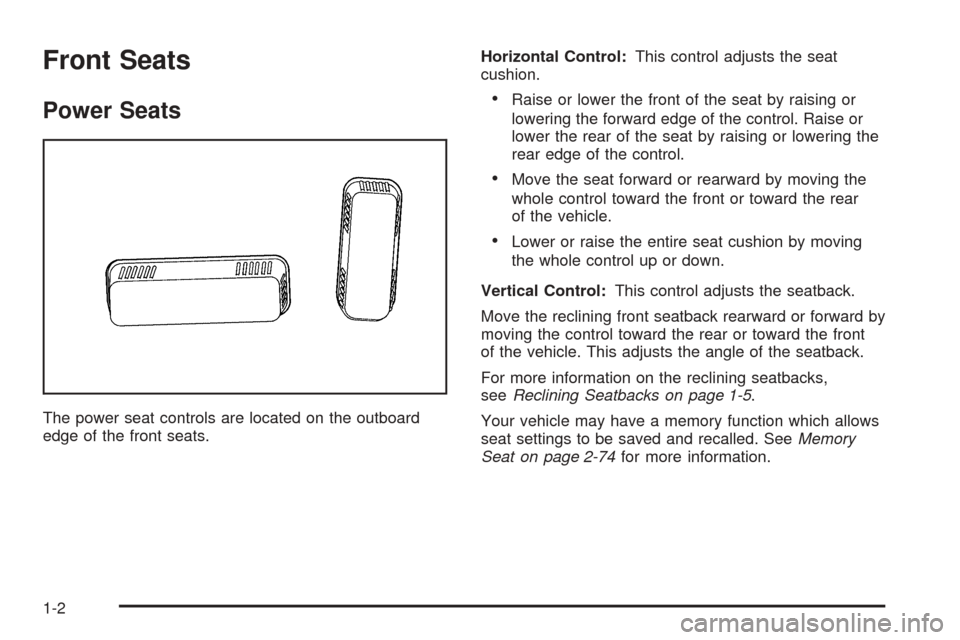
Front Seats
Power Seats
The power seat controls are located on the outboard
edge of the front seats.Horizontal Control:This control adjusts the seat
cushion.
Raise or lower the front of the seat by raising or
lowering the forward edge of the control. Raise or
lower the rear of the seat by raising or lowering the
rear edge of the control.
Move the seat forward or rearward by moving the
whole control toward the front or toward the rear
of the vehicle.
Lower or raise the entire seat cushion by moving
the whole control up or down.
Vertical Control:This control adjusts the seatback.
Move the reclining front seatback rearward or forward by
moving the control toward the rear or toward the front
of the vehicle. This adjusts the angle of the seatback.
For more information on the reclining seatbacks,
seeReclining Seatbacks on page 1-5.
Your vehicle may have a memory function which allows
seat settings to be saved and recalled. SeeMemory
Seat on page 2-74for more information.
1-2
Page 13 of 484
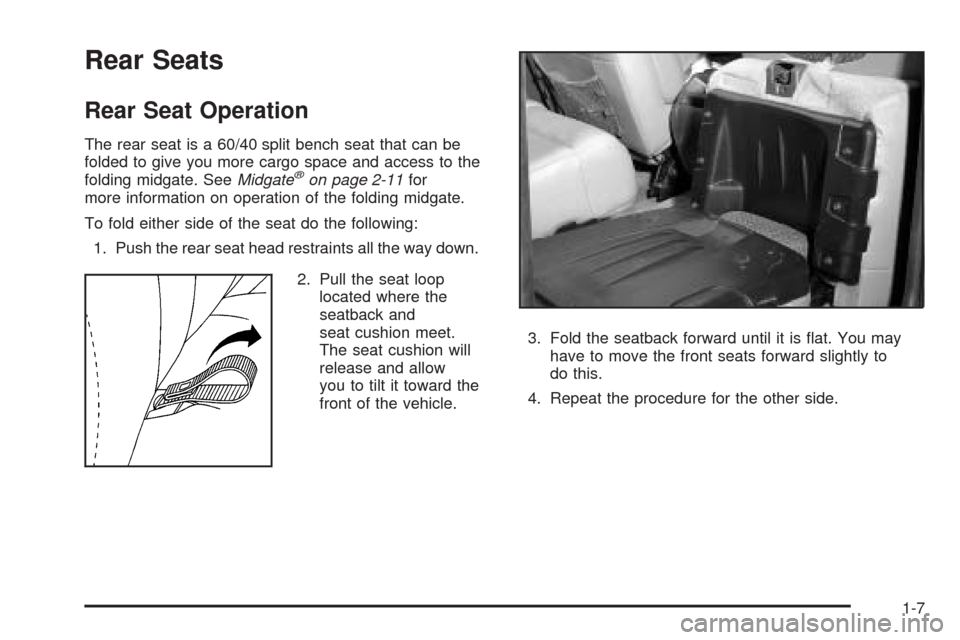
Rear Seats
Rear Seat Operation
The rear seat is a 60/40 split bench seat that can be
folded to give you more cargo space and access to the
folding midgate. SeeMidgate
®on page 2-11for
more information on operation of the folding midgate.
To fold either side of the seat do the following:
1. Push the rear seat head restraints all the way down.
2. Pull the seat loop
located where the
seatback and
seat cushion meet.
The seat cushion will
release and allow
you to tilt it toward the
front of the vehicle.3. Fold the seatback forward until it is �at. You may
have to move the front seats forward slightly to
do this.
4. Repeat the procedure for the other side.
1-7
Page 34 of 484
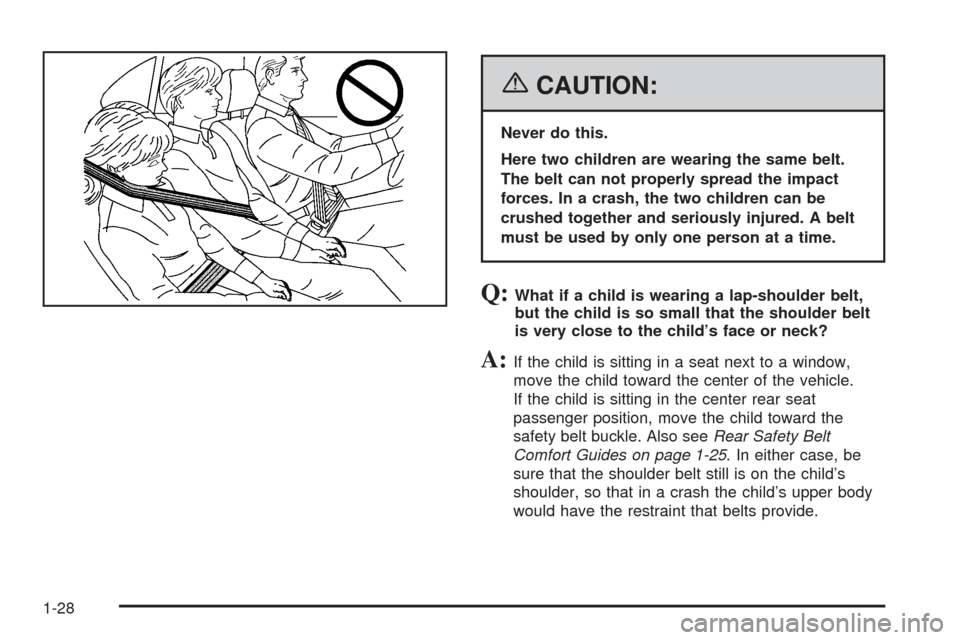
{CAUTION:
Never do this.
Here two children are wearing the same belt.
The belt can not properly spread the impact
forces. In a crash, the two children can be
crushed together and seriously injured. A belt
must be used by only one person at a time.
Q:What if a child is wearing a lap-shoulder belt,
but the child is so small that the shoulder belt
is very close to the child’s face or neck?
A:If the child is sitting in a seat next to a window,
move the child toward the center of the vehicle.
If the child is sitting in the center rear seat
passenger position, move the child toward the
safety belt buckle. Also seeRear Safety Belt
Comfort Guides on page 1-25. In either case, be
sure that the shoulder belt still is on the child’s
shoulder, so that in a crash the child’s upper body
would have the restraint that belts provide.
1-28
Page 39 of 484
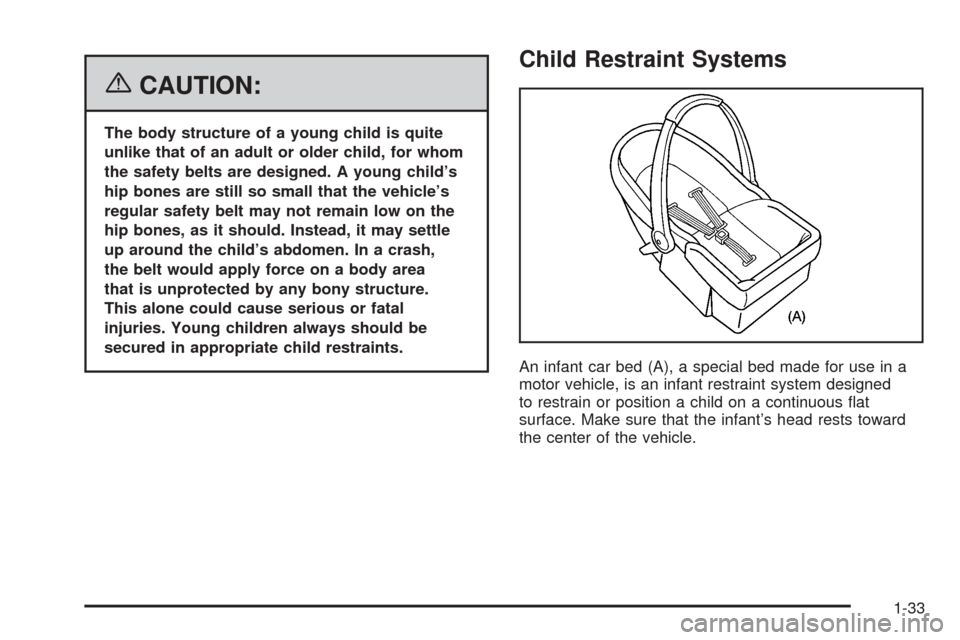
{CAUTION:
The body structure of a young child is quite
unlike that of an adult or older child, for whom
the safety belts are designed. A young child’s
hip bones are still so small that the vehicle’s
regular safety belt may not remain low on the
hip bones, as it should. Instead, it may settle
up around the child’s abdomen. In a crash,
the belt would apply force on a body area
that is unprotected by any bony structure.
This alone could cause serious or fatal
injuries. Young children always should be
secured in appropriate child restraints.
Child Restraint Systems
An infant car bed (A), a special bed made for use in a
motor vehicle, is an infant restraint system designed
to restrain or position a child on a continuous �at
surface. Make sure that the infant’s head rests toward
the center of the vehicle.
1-33
Page 64 of 484
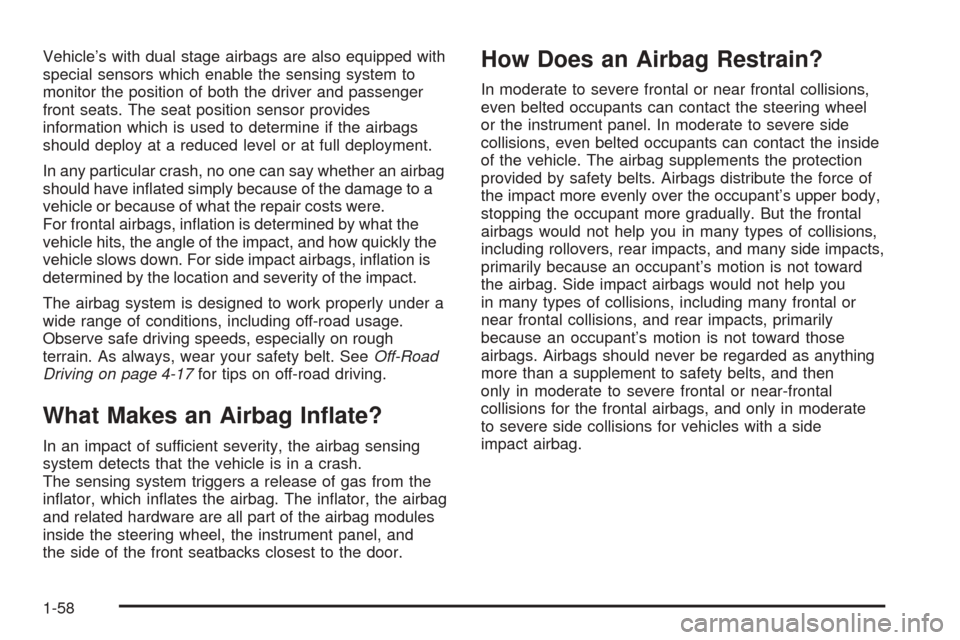
Vehicle’s with dual stage airbags are also equipped with
special sensors which enable the sensing system to
monitor the position of both the driver and passenger
front seats. The seat position sensor provides
information which is used to determine if the airbags
should deploy at a reduced level or at full deployment.
In any particular crash, no one can say whether an airbag
should have in�ated simply because of the damage to a
vehicle or because of what the repair costs were.
For frontal airbags, in�ation is determined by what the
vehicle hits, the angle of the impact, and how quickly the
vehicle slows down. For side impact airbags, in�ation is
determined by the location and severity of the impact.
The airbag system is designed to work properly under a
wide range of conditions, including off-road usage.
Observe safe driving speeds, especially on rough
terrain. As always, wear your safety belt. SeeOff-Road
Driving on page 4-17for tips on off-road driving.
What Makes an Airbag In�ate?
In an impact of sufficient severity, the airbag sensing
system detects that the vehicle is in a crash.
The sensing system triggers a release of gas from the
in�ator, which in�ates the airbag. The in�ator, the airbag
and related hardware are all part of the airbag modules
inside the steering wheel, the instrument panel, and
the side of the front seatbacks closest to the door.
How Does an Airbag Restrain?
In moderate to severe frontal or near frontal collisions,
even belted occupants can contact the steering wheel
or the instrument panel. In moderate to severe side
collisions, even belted occupants can contact the inside
of the vehicle. The airbag supplements the protection
provided by safety belts. Airbags distribute the force of
the impact more evenly over the occupant’s upper body,
stopping the occupant more gradually. But the frontal
airbags would not help you in many types of collisions,
including rollovers, rear impacts, and many side impacts,
primarily because an occupant’s motion is not toward
the airbag. Side impact airbags would not help you
in many types of collisions, including many frontal or
near frontal collisions, and rear impacts, primarily
because an occupant’s motion is not toward those
airbags. Airbags should never be regarded as anything
more than a supplement to safety belts, and then
only in moderate to severe frontal or near-frontal
collisions for the frontal airbags, and only in moderate
to severe side collisions for vehicles with a side
impact airbag.
1-58
Page 70 of 484
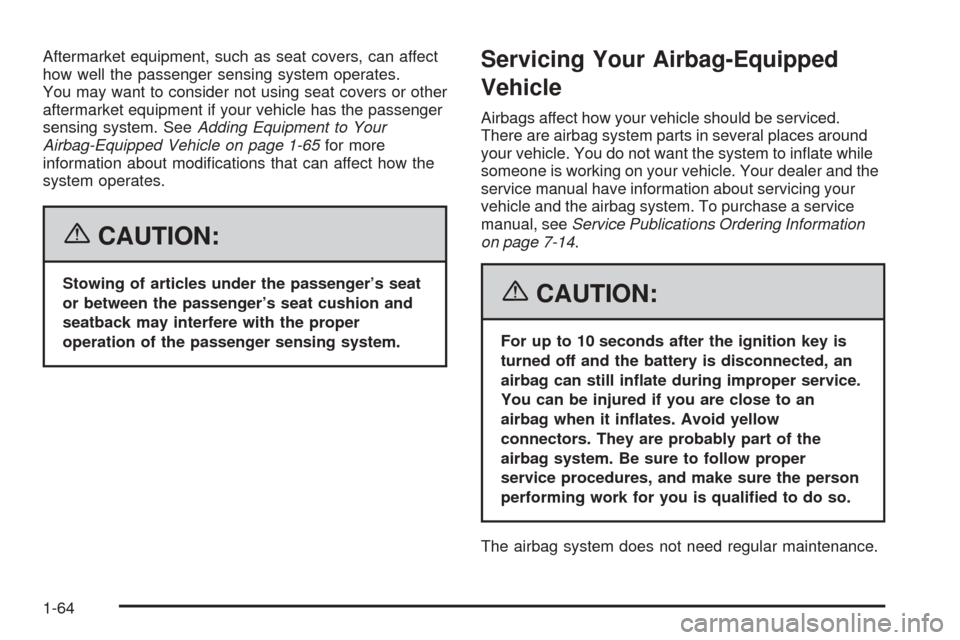
Aftermarket equipment, such as seat covers, can affect
how well the passenger sensing system operates.
You may want to consider not using seat covers or other
aftermarket equipment if your vehicle has the passenger
sensing system. SeeAdding Equipment to Your
Airbag-Equipped Vehicle on page 1-65for more
information about modi�cations that can affect how the
system operates.
{CAUTION:
Stowing of articles under the passenger’s seat
or between the passenger’s seat cushion and
seatback may interfere with the proper
operation of the passenger sensing system.
Servicing Your Airbag-Equipped
Vehicle
Airbags affect how your vehicle should be serviced.
There are airbag system parts in several places around
your vehicle. You do not want the system to in�ate while
someone is working on your vehicle. Your dealer and the
service manual have information about servicing your
vehicle and the airbag system. To purchase a service
manual, seeService Publications Ordering Information
on page 7-14.
{CAUTION:
For up to 10 seconds after the ignition key is
turned off and the battery is disconnected, an
airbag can still in�ate during improper service.
You can be injured if you are close to an
airbag when it in�ates. Avoid yellow
connectors. They are probably part of the
airbag system. Be sure to follow proper
service procedures, and make sure the person
performing work for you is quali�ed to do so.
The airbag system does not need regular maintenance.
1-64
Page 75 of 484
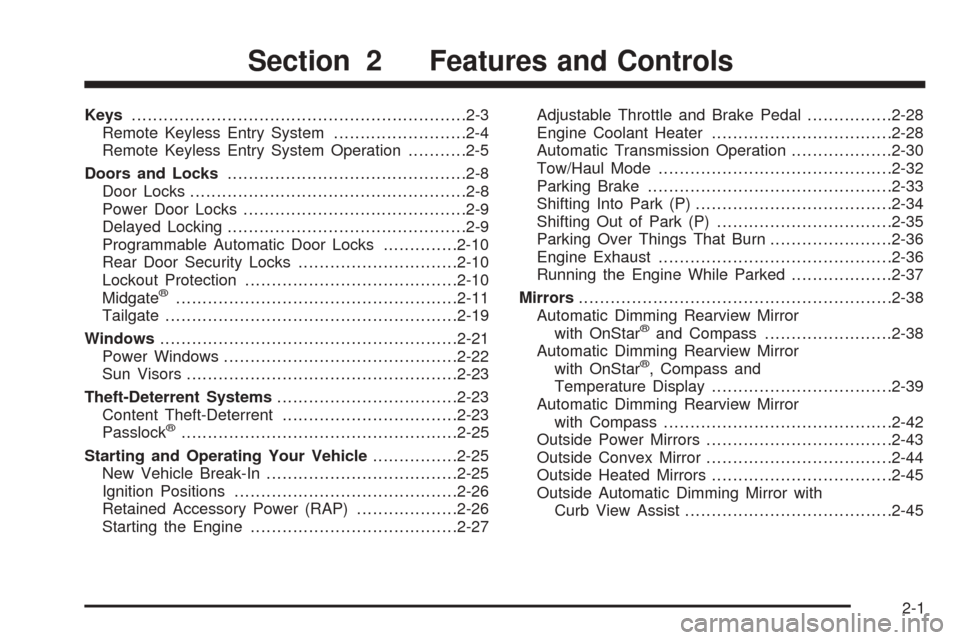
Keys...............................................................2-3
Remote Keyless Entry System.........................2-4
Remote Keyless Entry System Operation...........2-5
Doors and Locks.............................................2-8
Door Locks....................................................2-8
Power Door Locks..........................................2-9
Delayed Locking.............................................2-9
Programmable Automatic Door Locks..............2-10
Rear Door Security Locks..............................2-10
Lockout Protection........................................2-10
Midgate
®.....................................................2-11
Tailgate.......................................................2-19
Windows........................................................2-21
Power Windows............................................2-22
Sun Visors...................................................2-23
Theft-Deterrent Systems..................................2-23
Content Theft-Deterrent.................................2-23
Passlock
®....................................................2-25
Starting and Operating Your Vehicle................2-25
New Vehicle Break-In....................................2-25
Ignition Positions..........................................2-26
Retained Accessory Power (RAP)...................2-26
Starting the Engine.......................................2-27Adjustable Throttle and Brake Pedal................2-28
Engine Coolant Heater..................................2-28
Automatic Transmission Operation...................2-30
Tow/Haul Mode............................................2-32
Parking Brake..............................................2-33
Shifting Into Park (P).....................................2-34
Shifting Out of Park (P).................................2-35
Parking Over Things That Burn.......................2-36
Engine Exhaust............................................2-36
Running the Engine While Parked...................2-37
Mirrors...........................................................2-38
Automatic Dimming Rearview Mirror
with OnStar
®and Compass........................2-38
Automatic Dimming Rearview Mirror
with OnStar
®, Compass and
Temperature Display..................................2-39
Automatic Dimming Rearview Mirror
with Compass...........................................2-42
Outside Power Mirrors...................................2-43
Outside Convex Mirror...................................2-44
Outside Heated Mirrors..................................2-45
Outside Automatic Dimming Mirror with
Curb View Assist.......................................2-45
Section 2 Features and Controls
2-1
Page 87 of 484
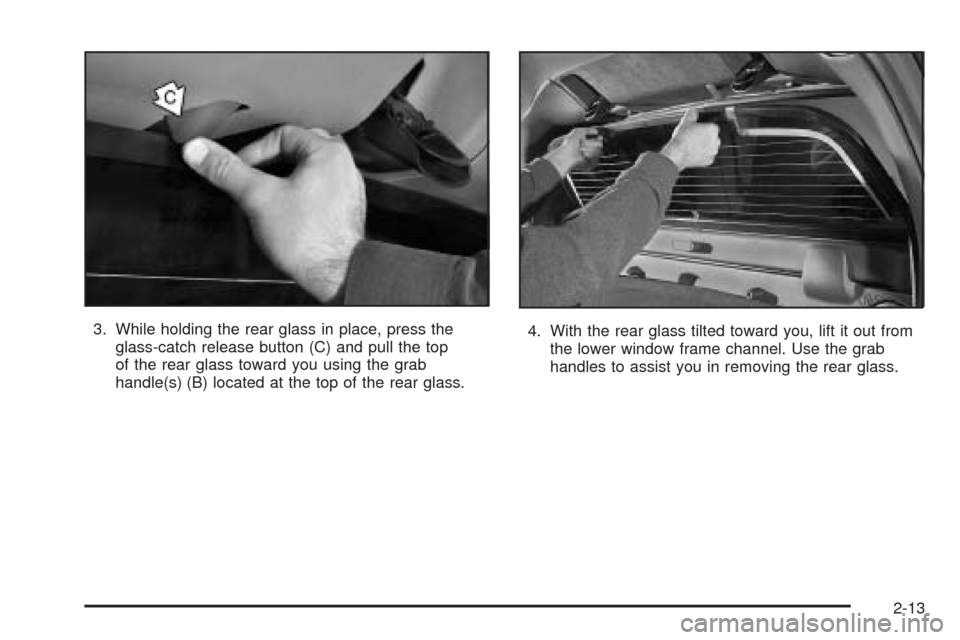
3. While holding the rear glass in place, press the
glass-catch release button (C) and pull the top
of the rear glass toward you using the grab
handle(s) (B) located at the top of the rear glass.4. With the rear glass tilted toward you, lift it out from
the lower window frame channel. Use the grab
handles to assist you in removing the rear glass.
2-13
Page 91 of 484
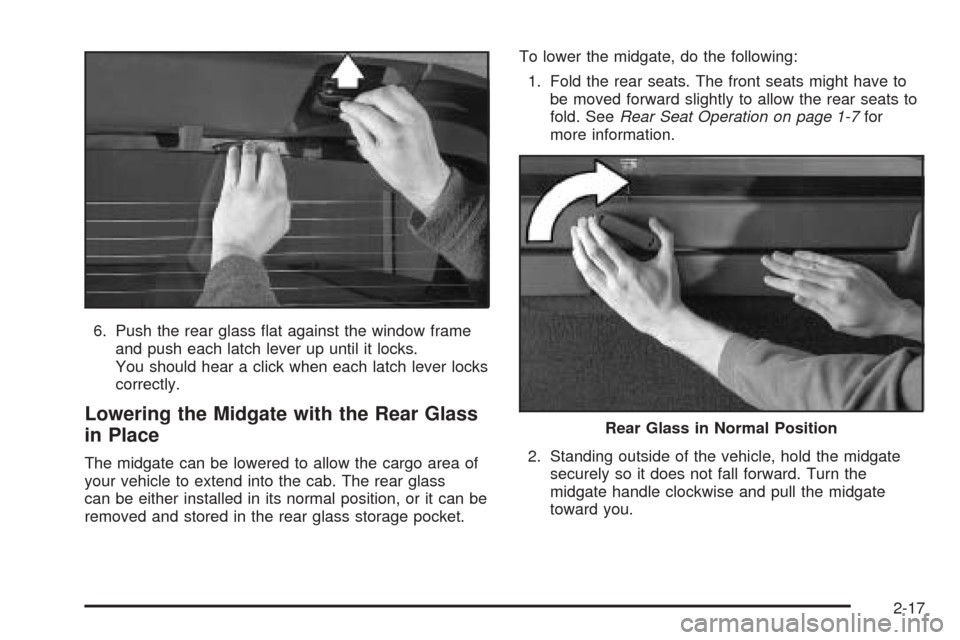
6. Push the rear glass �at against the window frame
and push each latch lever up until it locks.
You should hear a click when each latch lever locks
correctly.
Lowering the Midgate with the Rear Glass
in Place
The midgate can be lowered to allow the cargo area of
your vehicle to extend into the cab. The rear glass
can be either installed in its normal position, or it can be
removed and stored in the rear glass storage pocket.To lower the midgate, do the following:
1. Fold the rear seats. The front seats might have to
be moved forward slightly to allow the rear seats to
fold. SeeRear Seat Operation on page 1-7for
more information.
2. Standing outside of the vehicle, hold the midgate
securely so it does not fall forward. Turn the
midgate handle clockwise and pull the midgate
toward you.
Rear Glass in Normal Position
2-17